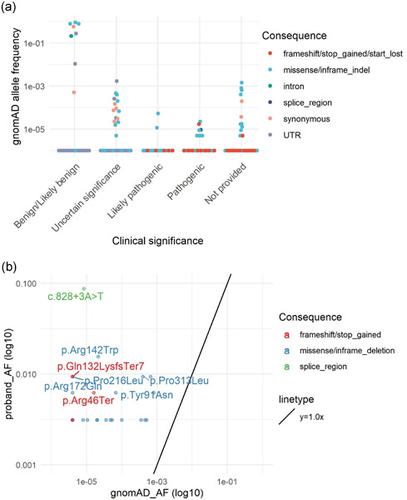当前位置:
X-MOL 学术
›
Hum. Mutat.
›
论文详情
Our official English website, www.x-mol.net, welcomes your feedback! (Note: you will need to create a separate account there.)
Genotype-phenotype associations in a large PRPH2-related retinopathy cohort.
Human Mutation ( IF 3.9 ) Pub Date : 2020-06-12 , DOI: 10.1002/humu.24065 Melissa J Reeves 1 , Kerry E Goetz 2 , Bin Guan 1 , Ehsan Ullah 1 , Delphine Blain 1 , Wadih M Zein 1 , Santa J Tumminia 2 , Robert B Hufnagel 1
Human Mutation ( IF 3.9 ) Pub Date : 2020-06-12 , DOI: 10.1002/humu.24065 Melissa J Reeves 1 , Kerry E Goetz 2 , Bin Guan 1 , Ehsan Ullah 1 , Delphine Blain 1 , Wadih M Zein 1 , Santa J Tumminia 2 , Robert B Hufnagel 1
Affiliation

|
Molecular variant interpretation lacks disease gene‐specific cohorts for determining variant enrichment in disease versus healthy populations. To address the molecular etiology of retinal degeneration, specifically the PRPH2‐related retinopathies, we reviewed genotype and phenotype information obtained from 187 eyeGENE® participants from 161 families. Clinical details were provided by referring clinicians participating in the eyeGENE® Network. The cohort was sequenced for variants in PRPH2. Variant complementary DNA clusters and cohort frequency were compared to variants in public databases to help us to determine pathogenicity by current American College of Medical Genetics and Genomics/Association for Molecular Pathology interpretation criteria. The most frequent variant was c.828+3A>T, which affected 28 families (17.4%), and 25 of 79 (31.64%) variants were novel. The majority of missense variants clustered in the D2 intracellular loop of the peripherin‐2 protein, constituting a hotspot. Disease enrichment was noted for 23 (29.1%) of the variants. Hotspot and disease‐enrichment evidence modified variant classification for 16.5% of variants. The missense allele p.Arg172Trp was associated with a younger age of onset. To the best of our knowledge, this is the largest patient cohort review of PRPH2‐related retinopathy. Large disease gene‐specific cohorts permit gene modeling for hotspot and disease‐enrichment analysis, providing novel variant classification evidence, including for novel missense variants.
中文翻译:

大型 PRPH2 相关视网膜病变队列中的基因型-表型关联。
分子变异解释缺乏用于确定疾病与健康人群中变异富集的疾病基因特异性队列。为了解决视网膜变性的分子病因学,特别是PRPH2相关的视网膜病变,我们回顾了从 161 个家庭的 187 名 eyeGENE® 参与者获得的基因型和表型信息。临床细节由参与 eyeGENE® 网络的推荐临床医生提供。该队列针对PRPH2中的变体进行了测序. 将变异互补 DNA 簇和队列频率与公共数据库中的变异进行比较,以帮助我们通过当前的美国医学遗传学和基因组学学院/分子病理学协会解释标准确定致病性。最常见的变异是 c.828+3A>T,影响了 28 个家族(17.4%),79 个变异中有 25 个(31.64%)是新的。大多数错义变异聚集在外周蛋白-2蛋白的D2细胞内环中,构成热点。注意到 23 个 (29.1%) 变体的疾病富集。热点和疾病富集证据修改了 16.5% 变体的变体分类。错义等位基因 p.Arg172Trp 与发病年龄较小有关。据我们所知,这是最大的PRPH2患者队列回顾相关的视网膜病变。大型疾病基因特异性队列允许对热点和疾病富集分析进行基因建模,提供新的变异分类证据,包括新的错义变异。
更新日期:2020-06-12
中文翻译:

大型 PRPH2 相关视网膜病变队列中的基因型-表型关联。
分子变异解释缺乏用于确定疾病与健康人群中变异富集的疾病基因特异性队列。为了解决视网膜变性的分子病因学,特别是PRPH2相关的视网膜病变,我们回顾了从 161 个家庭的 187 名 eyeGENE® 参与者获得的基因型和表型信息。临床细节由参与 eyeGENE® 网络的推荐临床医生提供。该队列针对PRPH2中的变体进行了测序. 将变异互补 DNA 簇和队列频率与公共数据库中的变异进行比较,以帮助我们通过当前的美国医学遗传学和基因组学学院/分子病理学协会解释标准确定致病性。最常见的变异是 c.828+3A>T,影响了 28 个家族(17.4%),79 个变异中有 25 个(31.64%)是新的。大多数错义变异聚集在外周蛋白-2蛋白的D2细胞内环中,构成热点。注意到 23 个 (29.1%) 变体的疾病富集。热点和疾病富集证据修改了 16.5% 变体的变体分类。错义等位基因 p.Arg172Trp 与发病年龄较小有关。据我们所知,这是最大的PRPH2患者队列回顾相关的视网膜病变。大型疾病基因特异性队列允许对热点和疾病富集分析进行基因建模,提供新的变异分类证据,包括新的错义变异。



























 京公网安备 11010802027423号
京公网安备 11010802027423号